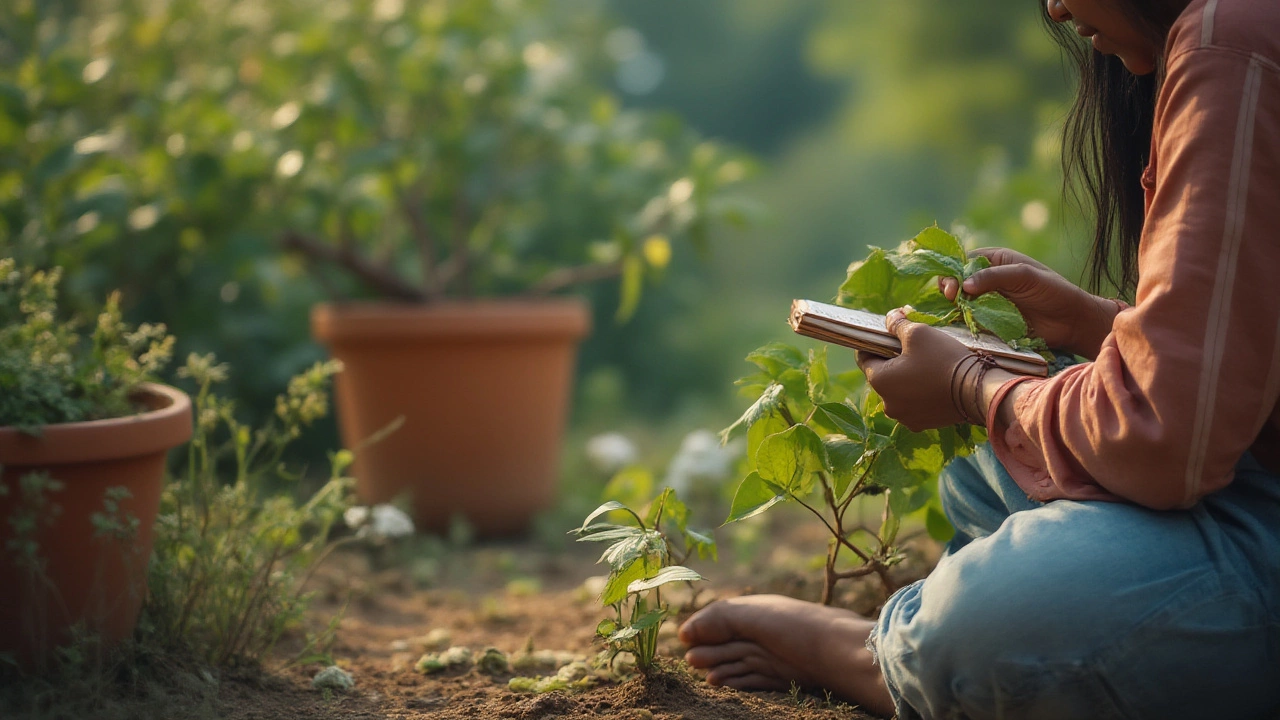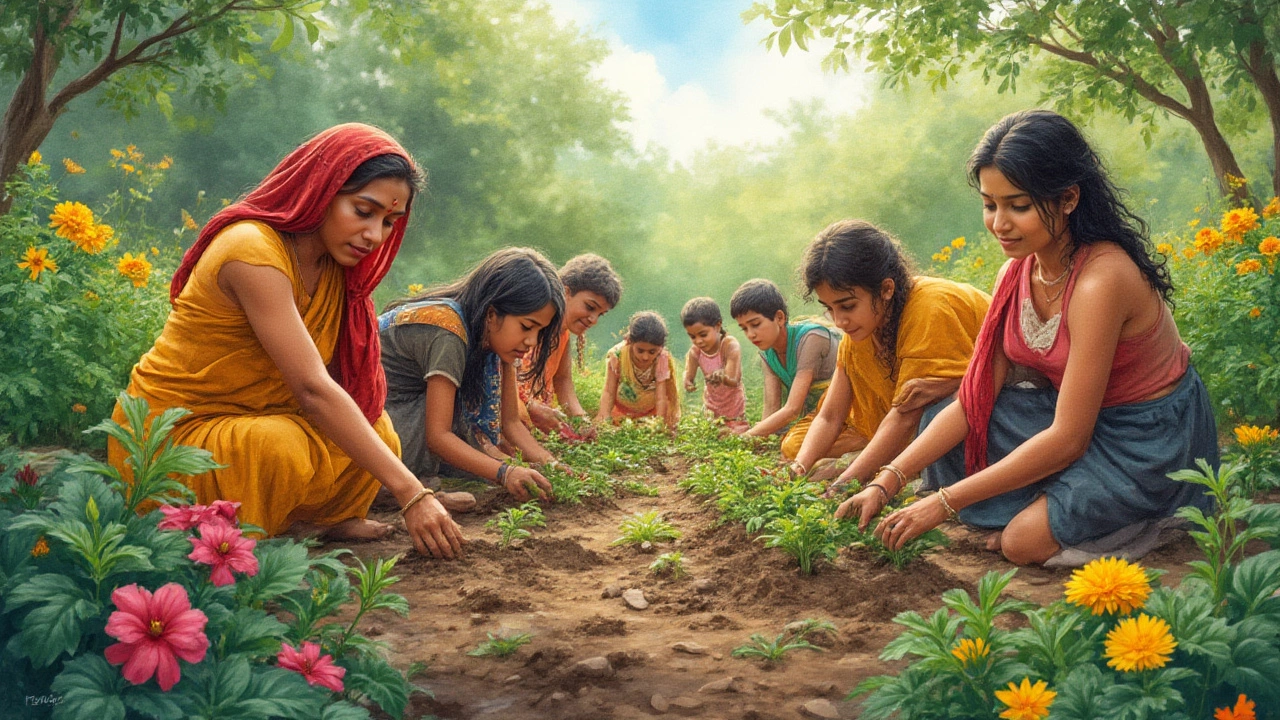Stubborn weeds beating you year after year? Lush tomatoes drooping with fruit while yours fade? You might be missing the traits that set apart good gardeners from the rest. Ask around and you’ll hear classic tales: someone who chats to their plants and their roses explode with color, while another, with every tool in the store, still has limp lettuce. Science backs up the idea that gardening success isn't just luck or expensive gadgets—it's a mix of attention, patience, and a quirky kind of curiosity. If you’ve ever wondered what separates the green thumbs from the frustrated crowd, you’re in the right patch.
The Mindset That Shapes a Good Gardener
Great gardeners aren’t born—most start out killing a fair share of plants. What keeps them going isn’t blind optimism or some magic touch. Instead, curiosity fuels them. They’ll poke at soil, sniff a wilting stem, search for insects under leaves. They want to know first, "What went wrong?" Scientists say pursuit of those little puzzles helps grow knowledge the way a sturdy root grows a healthy tomato. Jessica Walliser, a horticulturist who studied plant sufferings for two decades, claims that noticing small changes—like a hint of yellow on basil leaves—trains the brain to respond faster and smarter the next season.
Patience might sound obvious, but it’s everything in gardening. You can’t force seeds to shoot up overnight or expect fruit to ripen because you’re impatiently waiting for salsa night. Plants move at their own speed. Good gardeners resist the urge to overwater or dump too much fertilizer out of desperation. If a new variety fails, they adapt—the next year, maybe they’ll start seeds indoors earlier, or plant in a sunnier spot. That trial-and-error attitude sets the stage for real breakthroughs. Persistence, mixed with a willingness to accept failure, turns would-be flops into future bumper crops.
Resilience isn’t just about bouncing back from dead marigolds or a blight-stricken bed; it’s mental, too. Bad weather, surprise pests, or a workweek that eats up all your gardening hours—they’ll all happen sooner or later. The best gardeners learn not to quit, but to adjust. They listen to advice, but they also trust what works for them and aren’t too proud to ask neighbors for help. A study by the Royal Horticultural Society found that gardeners who leaned on supportive communities had healthier plots and reported less stress—turns out, being social does wonders for both plants and people.
Observation skills make a massive difference between ho-hum results and jaw-dropping displays. The sharp-eyed gardener notices when a plant’s growth is stunted and catches a root-bound pot before it’s too late. They recognize subtle signs, like the telltale trails of snails gliding through lettuce beds at dawn. Attention to detail also makes pest control or pruning less stressful; they know what’s normal and can spot the weird stuff right away. It’s a bit like detective work, but more satisfying: you see the tiny Japanese beetle, remove it, and the roses bounce right back.
Flexibility isn’t just changing up plans when the weather shifts. With changing climates, it can mean rethinking plant choices—maybe ditching thirsty grass for drought-tolerant native flowers. The best gardeners treat every season as its own lesson. If their tulips flop, they don’t mope; they swap in daffodils next year. Or maybe they discover that a "full sun" spot is actually too harsh for delicate seedlings and tweak their layout accordingly. That adaptability pays off in bigger harvests and less heartbreak.

Skills and Habits Every Good Gardener Develops
Knowing your soil is like understanding the foundation of your house—it supports everything. Experienced gardeners actually test their soil, often with inexpensive home kits. They know a reading of 6.5 pH is ideal for most veggies, but blueberries crave something closer to 5.5. They recognize the feel of rich loam versus stubborn clay. Some keep records year after year. This isn’t just busywork: in a Cornell University survey, gardeners who tracked soil health improved their yields by an average of 28% compared to those who guessed.
Good gardeners master the art of watering deeply, not just sprinkling the surface. Roots stretch farther and grow stronger when they have to hunt for moisture. A common tip from pros: stick your finger into the dirt—if it’s dry a couple inches down, it’s time to water. Drip irrigation isn’t just for tech-lovers anymore; even a moderately sized plot can benefit, saving both water and sweat. And rain barrels? Not just a trendy accessory—they cut water bills and reduce runoff, all while providing gentle, chlorine-free hydration that plants love.
Pruning used to intimidate me. The thought of snipping off healthy-looking greenery feels wrong, right? But wise gardeners know it’s the secret to bushier plants and the kind of roses you see in glossy magazines. They prune at the right times—roses and fruit trees in early spring, deadheading marigolds all summer. Sharp, clean tools matter, too. Every year, a surprising number of plants die from "pruner blight": illnesses that transfer when people use dirty shears. While nobody likes chores, giving your tools a quick cleaning after each use pays off big-time.
Plant selection isn’t just about what looks pretty at the nursery. Good gardeners study their region—what USDA hardiness zone they’re in, how many frost-free days to expect, which bugs love to drop by uninvited. They invest in perennial workhorses that keep returning, like coneflowers or peonies, and work in annuals for pizzazz. Native plants, adapted to local swings in temperature and rain, need less fuss and almost always outshine the imports. If you want real impact, try mixing heights, bloom times, and leaf textures—a garden that changes week to week feels like a living painting.
Efficient weeding is the love-hate chore every gardener faces. Mulch is a lifeline: a thick layer of wood chips, straw, or shredded leaves keeps weeds down, holds in moisture, and feeds soil as it breaks down. Some folks cover empty beds with cardboard or newspaper to smother weed seeds. Pulling weeds after rain, when the ground is soft, makes the job almost satisfying (almost). Savvier gardeners make it a habit, not a marathon—ten minutes every few days beats one miserable back-breaking afternoon.
| Skill/Habit | Impact on Garden |
|---|---|
| Soil Testing | Healthy roots, bigger harvests |
| Deep Watering | Stronger plants, less drought stress |
| Regular Pruning | More blooms, better airflow |
| Native Plant Selection | Less maintenance, attracts pollinators |
| Mulching | Fewer weeds, richer soil |
Fertilizing can get complicated fast, but good gardeners keep it simple. They often compost kitchen scraps and fallen leaves, building a living soil that barely needs store-bought food. A University of California study found gardens using homemade compost produced 25% more tomatoes and strawberries than synthetic fertilizers. If they do buy fertilizer, they know that "10-10-10" labels refer to equal parts nitrogen, phosphorus, and potassium—the big three nutrients for plant health. They spread it modestly, never dumping heaps that just wash away in a rainstorm and pollute local streams.
Record-keeping might sound boring but turns into gold over time. A simple notebook or a phone app lets you jot down planting dates, yields, and weather oddities. Looking back, you’ll see patterns—maybe your snap peas always bolt early, or a certain pest predictably arrives by mid-June. Veteran gardeners love sharing their data and tips, turning what feels like a solo endeavor into a low-key community project.
One trait beginners overlook: noticing and welcoming wildlife. Good gardeners don’t wage all-out war on every bug or bird—they know pollinators and predatory insects keep things in balance. A messy corner with brush or a patch of wildflowers can be an invitation for ladybugs, lacewings, and bees that pay the garden back a hundred times. Bird baths and shallow water dishes draw in helpers, and honestly, a toad under the beans almost always means fewer slug problems.

Tips, Tricks, and Insights for Aspiring Gardeners
If you’re just starting, don’t rush. Choose a few easy crops your first season—radishes, lettuce, or nasturtium flowers are hard to mess up. Read up on your local frost dates; plant too early, and you’ll spend weeks nursing half-frozen seedlings. Try one new thing each year, whether it’s a weird tomato variety or composting kitchen scraps.
Gardeners who want to save on costs swap seeds with neighbors or join a community exchange. A packet of seeds might cost two bucks, but one healthy plant can produce hundreds more. Sharing tools also makes sense—your neighbor’s rototiller or your cousin’s pruners might get more use this way. Besides, you’re more likely to swap stories that teach you something you can’t find in books.
Don’t be shy about using technology. Weather apps aren’t just for checking picnics—they let you spot an unexpected cold snap and cover your plants. Plant ID apps snap a picture and instantly tell you if that weed is an edible purslane or something you really should pull. Smart sensors can tell you, to the hour, when your garden bed dries out—though honestly, nothing beats the finger-in-the-soil test for most home growers.
If you battle pests, skip the chemical arms race when possible. Mix up a quick DIY spray of soapy water for aphids, or sprinkle crushed eggshells at the base of your tenderest plants—snails hate crawling over sharp bits. Many gardeners swear by interplanting: putting marigolds near tomatoes or basil among peppers. It really does make a difference—studies show that marigolds can repel certain root-destroying nematodes and attract beneficial insects.
One underappreciated trick: change your perspective. Step back and see your garden through a visitor’s eyes. Try snapping a few photos or quickly sketching the layout. This helps you spot uneven growth, too much bare soil, or a cluttered corner crying out for something tall and dramatic. Creative arrangement isn’t about strict rules but about what pleases you most when you walk by at sunset with a cold drink in hand.
Get your hands dirty. Gloves are fine, but touch the soil, feel the moisture, and get used to the rhythm of the seasons. Modern studies show that soil microbes boost serotonin levels, giving gardeners a real mental health lift. Maybe that’s why folks with a few decades of dirt under their nails seem happier than most—it's the microbes talking.
Curiosity shouldn’t fade as you gain experience. Try planting an unusual vegetable, learn about a forgotten flower from your grandparents’ garden, or read up on regenerative methods like no-dig beds. There’s something to be said for keeping gardening fresh, even after years of digging and dreaming.
Here’s something you might not have heard: smell and taste your plants. Not in a survivalist way, but just to check health. Basil that smells bland or tomatoes that taste mealy? Could signal issues in the soil or missed nutrients. Use your senses as early warning tools—plants that smell, look, and taste right are most likely thriving.
Finally, trust yourself. Advice floats everywhere (and you’ll get plenty you never asked for), but your garden is yours. Track what works, tweak your habits, and don’t let a few brown leaves turn you off. The best gardeners make mistakes, pick up clues, and get better every year—one story at a time, one season at a time. So shake up your routine, stay persistent, and you'll find your own green thumb emerging in ways that surprise you.

